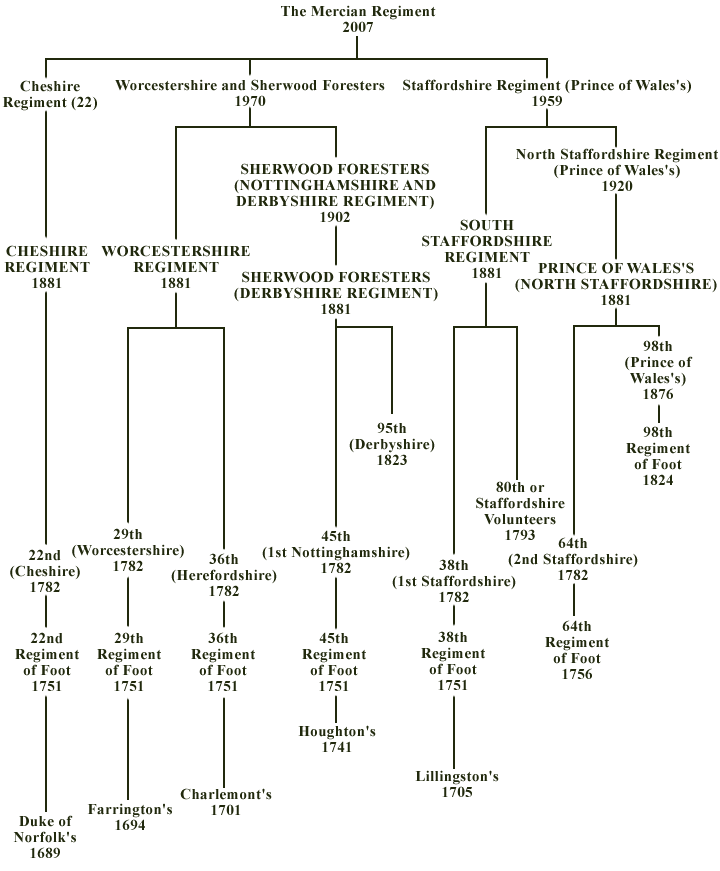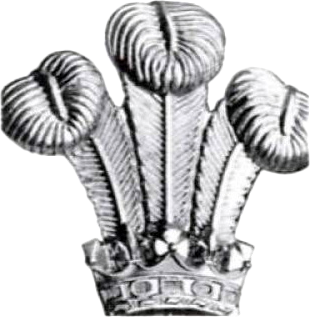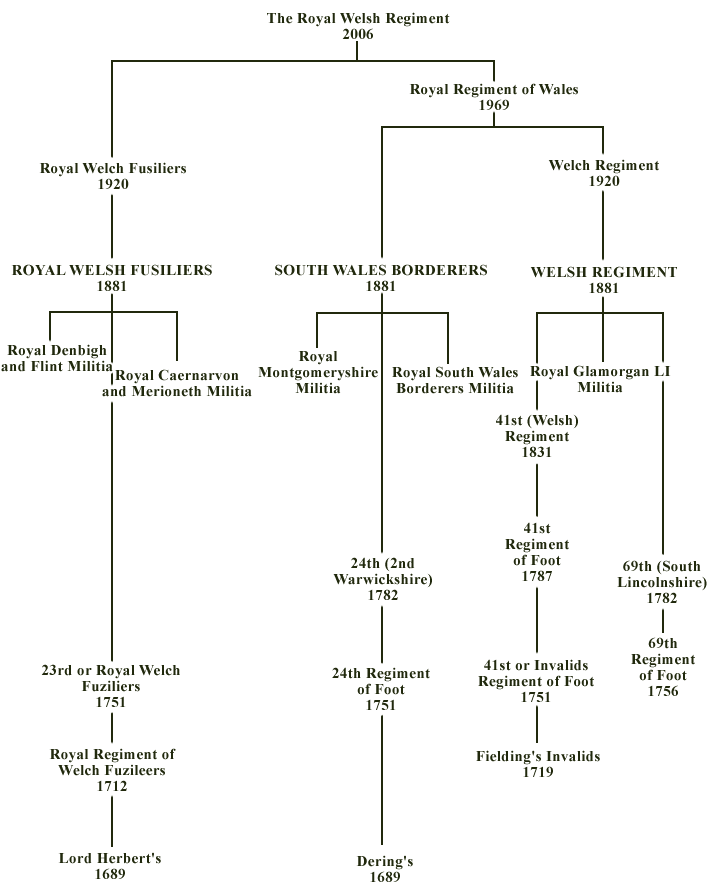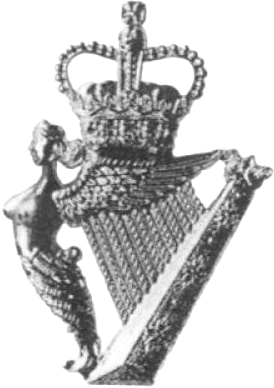
P.D. GRIFFIN
ENCYCLOPEDIA OF MODERN BRITISH ARMY REGIMENTS
Future Army Structures of 2004 nominated three county regiments of central England for amalgamation under the title of Mercian Regiment. Mercia was the kingdom that spread across the Midlands in Anglo-Saxon times. Battalions affected are 1st Cheshire (RHQ at Chester Castle), 1st Worcestershire and Sherwood Foresters (RHQ at Norton Barracks near Worcester) and 1st Staffordshire Regiment (RHQ at Whittington Barracks near Lichfield).
County attachments run deep. The 22nd (Cheshire) Regiment was raised on the Roodee at Chester in 1689 and the South Staffords were born of local volunteers, many from the county's militia. The 38th (1st Staffordshire) Regiment, formed in 1705 at the King's Head in Lichfield, was remembered on the tercentenary in 2005 when a regdmental deputation revisited the King's Head to mark the occasion. The romantic term 'Sherwood Foresters' originated in 1814, when the Prince Regent approved the title Royal Sherwood Foresters to the Nottinghamshire Militia after it had guarded royal buildings in London during the previous year. The name also settled temporarily on the 45th (1st Nottinghamshire) Regiment around 1866.

Blue caps and berets currently display one of three badges: the Cheshires' star and acorn, the WFR's elongated star and cross, the Staffords' knot and plume. The Cheshires' Victorian star is characterised by an acorn and oak leaf centre, which came from King George II at the Battle of Dettingen according to legend, although it is known that the arms of the founder of the regiment, Henry Howard, 7th Duke of Norfolk, included a horse with 'in its mouth an acorn sprig with two leaves'.

Provost corporal of the Staffordshire Regiment in No. 1 dress 'blues' with the glider sleeve badge. (Grenadier Publishing)
The Dettingen theory has it that a detachment of the 22nd guarded the King on the field of battle in 1743 and was presented with a clutch of oak leaves plucked from a tree, which is why the Cheshires wear oak leaves on the cap in the presence of royalty and on special days.

WFR officers in different orders of dress, 1996; the orderly officer, left, in mess kit complete with duty sword. (Grenadier Publishing)
The Stafford knot, from the arms of the earls of Stafford, has been used by regiments and departments associated with the county for over two centuries. The Staffordshire Regiment wears the knot with the Prince of Wales's crest, a combination first seen in the North Staffordshire Regiment. The crest came from the 98th, which took the Prince's title in 1876 after he had presented new colours to the battalion on Malta, a compliment to the previous 98th, the Prince of Wales's Tipperary Regiment (1805-1815). The Stafford knot is worn with the buff holland backing that was added to the South Staffordshires' cap badge in 1935 to symbolise the sacking used to repair uniforms during the extraordinary span of service endured by the 38th Regiment in the West Indies from 1706 to 1766. Alliances with the Jamaica Defence Force and the Antigua Barbuda Defence Force commemorate this period of the South Staffords' history.

At the Staffords' Tercentenary Weekend in 2005. A grenadier from the America-based 'Black Knots' re-enactment society (left) admiring the regimental mascot Watchman, with his handler and an expert of the 80th Regiment in the uniform of 1879 (centre). The 'Black Knots' represent the 64th Regiment in the American War of Independence
The Worcestershire Regiment's elongated star with the Sherwood Foresters' badge superimposed - a Maltese Cross (from the former 95th Rifles) with a stag in the centre - forms the badge of the WFR. The elongated star is a copy of that worn by officers of the Coldstream Guards, a tradition of the 29th Regiment, whose founder, Thomas Farrington, was once a Coldstreamer. The 29th won special permission to wear their star (like the Coldstream) on the pouch and valise, by which custom they became known as 'The Guards of the Line'. The motto, Firm, which has been a feature of the Worcesters' star since 1881, was sanctioned to the 36th Regiment some sixty years before, probably in recognition of its steadfast rearguard action at the Battle of Lauffeldt in 1747. TA units based at Nottingham are responsible for the old volunteer regiments of the county and are guardians of their traditions, which include the Robin Hood Battalion's 1939-45 Belgian Croix de Guerre ribbon.

Staffords' Corps of Drums in the 1980s
The South Staffords' brass glider badge, awarded for their airborne landings on Sicily in 1943, is worn by all ranks at the top of the right sleeve.
Regimental colouring dominates the uniforms. The buff facings of the 22nd Regiment, restored to the Cheshires in 1904, now appear on drummers' scarlet jackets. No. 1 dress 'blues' imitate this with buff piping around the shoulder straps. After the 1960s, Cheshire Regiment drummers broke with accepted custom and adopted dress cords coloured cerise and buff. Sergeants and above wear a cerise lanyard in No. 2 dress and cerise pullovers in barrack dress. Cerise- and buff-striped stable belts are fitted with a clasp fashioned with the numeral 22, a promotion of the pre-1881 title that is rarely seen in other regiments today.
WFR drummers wear scarlet tunics with facings of Lincoln green, a shade adopted by the Sherwood Foresters in 1913 and the Worcesters in 1920. Green facings had been a distinction of the 36th and 45th Regiments, and the Derbyshire Militia. The green theme is continued in WFR stable belts, lanyards and No. 1 dress piping.
Staffords' drummers have scarlet tunics embellished with the yellow facings returned to the South Staffords in 1936. No. 1 dress, likewise, has yellow piping, but their scarlet mess jackets bear the black facings of the 64th Regiment, ordered to the North Staffords in 1937. This is the preferred look in the Staffordshire Regiment, which now turns out in black belts, black jerseys for barrack dress and black shoes in service dress.
The Staffordshire Regiment is an arrangement of the former regimental marches Come Lasses and Lads (South Staffords, ex- Staffordshire Militia) and The Days We Went a Gypsying (North Staffords). The 80th, the Staffords' inspection march, the fifes and drums' We'll Gang Nae Mair to Glasgow Toun, and The Gemel Jager Marsch, adopted on the liberation of Norway in 1945; all come from the South Staffords.
God Bless the Prince of Wales was adopted by the North Staffords in support of their 1876 title. Zakhmi Dil or The Afghan March is from the same regiment.
Royal Windsor, now played with the Foresters' Young May Moon, was presented to the 29th Regiment by Princess Augusta at Windsor in 1791.
The Duchess of Kent, now the WFR slow march, is another legacy of the Worcestershire Regiment, whose custom it was to play The Lincolnshire Poacher before other marches to honour their affiliation to the Lincolnshire Regiment, and Rule Britannia at the conclusion in memory of their part in the great naval victory of 1 June 1794. Their assembly march, Hearts Of Oak, also dates from this episode in the regiments history.
Crich Memorial, named after the Sherwood Foresters' war memorial, which stands on a high hill overlooking Derbyshire and Nottinghamshire, was adopted by the regiment as its slow march in 1957. The Foresters' call (played on a cornet) was based on a carillon of bells which used to be tolled at a nunnery in Spain during the Peninsular War. Legend tells the story of the mother superior presenting the score to the 45th Regiment in gratitude for sparing her charges 'the rights of the victor'.
Wha Wadna Fecht for Charlie, the unlikely quick march of the Cheshire Regiment, was an old Jacobite tune accepted by the 22nd Regiment in 1851 for its reference to the name Charles. The march is played in homage to Gen Sir Charles Napier, who led the 22nd (Cheshire) Regiment to victory against the emirs of Scinde in 1843. The Cheshires' slow march is The 22nd Regiment 1772, their assembly a combination of A Hundred Pipers and the traditional county song The Miller of the Dee.

Badajoz Day, 1964. Sherwood Foresters with ram mascot and red jacket ceremony
The 1843 Scinde campaign is a proud chapter in the history of the Cheshire Regiment, not least because the 22nd (Cheshire) was the only British regiment under Napier's command when he defeated a Baluchi army 30,000 strong at Meeanee. The three battle honours 'Meeanee', 'Hyderabad' and 'Scinde' are unique to the Cheshires in the British Army and Meeanee Day (17 February) is celebrated annually.

Painting of the 22nd (Cheshire) Regiment at Meeanee in 1843. (National Army Museum)
The Cheshires' membership of the Wolfe Society came through the 22nd, which had joined Amherst's 1758 expedition to capture the port of Louisburg on Cape Breton Island. The grenadier company was detached for Wolfe's assault on Quebec in the following year when, at the height of battle, the general died in the arms of Henry Brown of the 22nd. The Foresters' place in the society came courtesy of the 45th Regiment, which served at the Siege of Louisburg with James Wolfe.
Badajoz Day (6 April) is celebrated in the way of the Sherwood Foresters, with a red coat flown from a flagpole to mark the action of Lt McPherson in the siege of this Spanish border fortress in 1812. When the 45th Regiment reached the citadel, McPherson signalled his section's achievement by running his coat up the flagpole. The Foresters' colours would be trooped on this day and then given over to the sergeants' mess, which hosted a ball in memory of those 'Old Stubborns' who fell at the Siege of Badajoz.
On Alma Day (20 September) tradition dictates that the drums captured by the 95th (Derbyshire) at the Battle of the Alma in 1854 are paraded and the regimental colour is carried by a common soldier in memory of Pte Keenan, who took up the colour after several officers had been killed in the attempt to keep it flying. The dangerous position of colour parties in war led to an army order to the effect that colours would no longer be carried in battle after the Alma. The 95th, which had been in existence for thirty years at the time of the Crimean War, were known as 'The Hosiers' after Derbyshire's hosiery trade and 'The Nails' from the hard nature of the men.
The Glorious First of June was celebrated by Worcesters everywhere to honour the 29th Regiment and its tour of duty with Lord Howe's fleet in the naval victory of 1794. The naval crown borne on the regimental colour today was awarded to the Worcestershire Regiment in 1909 for this action. The loyal toast was made in naval fashion with a special procedure in which the mess president would both propose and make the toast.
The custom of wearing swords in the mess originated in 1746, when officers of the 29th were attacked at dinner by American Indians. For the next 104 years all officers of the regiment wore swords when dining, but from 1850 onwards only the orderly officer and the officer of the week were required to keep the custom. Today the WFR orderly officer and duty field officer wear their swords in the mess but all other officers wear their sword frogs on the Sam Browne belts as a matter of course.
Pte Derby is the regiment's ram mascot, a legacy of the Sherwood Foresters, who maintained the ram traditions of the 95th Regiment and the Derbyshire Militia - a custom probably inspired by the old Jacobite song that was once made into a regimental march, The Derby Ram. The first ram was acquired by the 95th during the Siege of Kotah in the Indian Mutiny of 1857. Notable successors were Derby VIII, presented by the Maharajah of Alwar, and Derby X (1900-7), given by the Duke of Devonshire, the first in a long line of Swaledale rams from the herd at Chatsworth. The Staffordshire Regiment owns bull terrier mascots, each with the name Watchman, a custom begun in 1949 when the 6th Battalion North Staffordshire Regiment (TA) was presented with a Staffordshire bull terrier.
Ypres Day (31 July) commemorates the 1st North Staffords' attack on the first day of hostilities at Ypres in 1917.
Ferozeshah Day (21 December) celebrates the 80th Regiment at the Battle of Ferozeshah in 1845. It was the custom of the South Staffords for the colours to be handed over to the sergeants for the day in honour of Sgt Kirkland, who received a battlefield commission for his capture of a Sikh standard in the fray.
If neither of these anniversaries can be observed in any year then Anzio Day (22 January) or Arnhem Day (17 September) may be substituted. Whichever day is selected, the Ferozeshah sergeants' custom is employed.

The Royal Welsh Regiment (RWR) formed as three battalions on St David's Day 2006: the Royal Welch Fusiliers, the Royal Regiment of Wales and the Royal Welsh Regiment (TA).
The Royal Welch Fusiliers were born at Ludlow in 1689 under Lord Herbert of Chirbury. Although they recruited all over Wales, the Fusiliers annexed the militia regiments of north Wales in 1881 and established bases at Wrexham and Caernarvon.

The Royal Regiment of Wales (RRW), which also dates back to 1689 through its antecedent 24th of Foot, is an amalgamation of the South Wales Borderers (RHQ at Brecon) and the Welch Regiment (RHQ at Cardiff). The RRW headquarters were set up in the Cardiff barracks in 1969.

Corporal and officer of the Royal Welch Fusiliers in No. 2 dress, the flash clearly visible on the officer's jacket. (RWF Museum)
The blue peaked cap with scarlet band was worn in the forming regiments, though the Fusiliers confined it to officers' uniforms. Other ranks of the RWR now conform to fusilier fashion and wear the regimental khaki beret with the Prince of Wales' badge on a green backing, with the white hackle of the Fusiliers. The Prince of Wales' crest, which was adopted by the RWF in 1714 and the 41st in 1831, became the cap badge of the Welsh Regiment in 1881 and the RRW in 1969. The beret hackle, adopted by the RWF after the Second World War, replicates the white plume that had been worn on their full dress caps since 1768.
RWR collar badges incorporate the wreath of immortelles that displaced the sphinx on Borderers' collar badges in 1958, the Welsh dragon collar badge of the Welch Regiment (which was combined with the wreath for the RRW) and the Fusiliers' grenade. The ancient Welsh dragon badge was adopted by Welsh militia regiments and passed on to the Welsh regulars in 1881.

The Neuville's painting of the 24th at Rorke's Drift, 22 January 1879
The unique flash of five black swallow-tail ribbons that hangs from the back of the collar in No. Is, No. 2s and mess dress, is an eighteenth-century relic originally worn to tie the queue bag that kept the powdered wig from staining the red coat. When queues were abolished in 1808 officers of the 23rd Fusiliers continued to wear the ribbons, but Lt Col Harrison had to defend their use in 1834 and dashed off to seek permission from the King, who granted the flash as a 'peculiarity whereby to mark the dress of that distinguished regiment'. The distinction was later extended to senior sergeants of the RWF, and to other ranks in 1900.

Band and drums of the Royal Regiment of Wales, c. 1990. (MoD)
The green half of the regimental stable belt relates to the green belts of the RRW, which were based on the green facings of the 24th and 69th Regiments - and the SWB from 1905. Shoulder belts worn by ensigns, goat majors and drum majors bear the motto taken by Lt Col Williams from the Mackworths of Usk for his 41st Regiment in 1831 - Gwell angau na chywillyd (Death rather than dishonour).

RWF goat major with regimental goat at Caernarvon Castle, the ceremonial pioneers on parade. (RWF Museum)
Full dress scarlet is issued to drummers, goat handlers and RWF pioneers. A white Victorian tropical helmet adopted by the RRWT around the 100th anniversary of the Zulu War of 1879 invokes a famous episode in the history of the South Wales Borderers brought to public attention in the film Zulu.
The British Grenadiers was imposed on all fusilier regiments around 1835 because of the grenadier bearskins which adorned these regiments at the time.
The War Song of the Men of Glamorgan together with Forth to the Battle form the RWF slow march. The contrary reference to southern Wales here vies with Men of Harlech in the RRW.
The Royal Welch Fusiliers, penned by John Philip Sousa, was presented to the regiment of that name in 1930 to mark its fellowship with the US Marine Corps forged in the Boxer Rebellion of 1900.
Men of Harlech, the RRW quick march, was inherited from the South Wales Borderers, who came by it through their militia battalions.
Scipio, written by Handel when the 41st was filling with disabled veterans from Marlborough's wars, was chosen to be the RRW slow march.

The youngest private in the 1st Welch eating the leek on St David's Day, 1952, on active service in Korea; mascot Taffy VII held in check by Goat Maj Williams. (RRW Museum)
Other marches of the regiment are God Bless the Prince of Wales, Ap Shenkin (1st Welch), The Lincolnshire Poacher (2nd Welch, ex-69th) and Warwickshire Lads (24th Regiment).
On dinner nights hymns played in the 41st Regiment during the Afghan War of 1842 are traditionally aired. Sun of my Soul, Spanish Chant and Vesper Hymn were played by the band of the Welch Regiment on Sunday evenings.
All battalions keep a goat to take pride of place on parades. The earliest recorded example was that of the 23rd (Royal Regiment of Welch Fuziliers), whose goats preceded the mascots of other regiments by many decades. The first goat from the royal herd was presented to the 23rd by Queen Victoria in 1844, a decade before the 41st acquired its first. The animals are the essence of the regiment, and once accompanied their battalion on campaign and even into battle. The Borderers had few Welsh traditions and never took goats, but the RRW continued the Welch Regiment tradition and named its goats Taffy, Shenkin, Dewi or Sospan according to battalion custom.
St David's Day (1 March) is observed with the time-honoured ritual developed by the 23rd Fusiliers. Newcomers to the officers' mess, the sergeants' mess and the other ranks' dining hall are required to eat a raw leek in their respective venues to a drum roll under the watchful eye of the regimental goat. All ranks wear a leek in their headdress and in the Fusiliers a toast is made to 'Toby Purcell, His Spurs and St David'. This toast remembers a senior officer of the regiment, who fought at the Battle of the Boyne in 1690, and his spurs, which were passed on to successive seconds in command until lost to a fire in 1842. A dispensation from the need to drink the loyal toast or to stand for the national anthem on other days of the year came from the Prince Regent, who was cognisant of the 23rd Fusiliers' loyalty during the mutiny at the Nore in 1797. A RWF tradition in which officers ride in a five-mile steeplechase for the Red Dragon Cup was started on St David's Day, 1838.
Rorke's Drift Day (22 January) is when young recruits are initiated in the history of the regiment, principally the celebrated exploits of B Company, 2nd Battalion the 24th Regiment at the mission station at Rorke's Drift in South Africa. This small band of men stood alone against a Zulu army of some 4,000 warriors and held it at bay for two days and a night, just after the 1st Battalion had been annihilated by the same impi at nearby Isandhlwana. The 24th won a record number of Victoria Crosses, first to five men of the 2nd Battalion, who rescued a shore party from hostile natives on the Andaman Islands in 1867, and then to seven men of the same battalion for the defence of Rorke's Drift in 1879.
On Rorke's Drift Day the colours are paraded through barracks to let everyone see the silver wreath of immortelles that is permanently attached to the Queen's colour. This unique honour was approved by Queen Victoria in December 1880, some months after she had asked to see the Queen's colour of the 1st Battalion, which had been rescued from the bloodbath at Isandhlwana by Lts Melvill and Coghill.
They rushed it from the battlefield only to be slowed down by the strong current of the Buffalo river before being overpowered by Zulus. The colour was found the next day further downstream.
Gheluvelt Day (31 October) commemorates the 1914 battle in which both the Welsh Regiment and the South Wales Borderers had committed battalions to heavy loss. The Worcesters gave valuable support at the Chateau Gheluvelt and greetings are still exchanged with them.
Many infantry regiments have paraded ceremonial pioneers to commemorate the days when regimental pioneers went before the marching battalion to cut a path through natural obstacles with assorted tools, but only the RWF sought the proper authority to parade with ceremonial pioneers. They saw this as a privilege that required suitable representation and always made sure that a section of eight pioneers wearing a white buckskin apron and gauntlets marched at the head of the battalion, second only to the regimental goat. The pioneer sergeant's beard is a symbol of his experience, as his section's polished shovels, mattocks, axes and picks are symbols of their trade.
The RWF journal Y Ddraig Goch (the Red Dragon) testifies to the Welsh language spoken in the regiment, a skill that has proved useful on active service when radio messages have to be unintelligible to the enemy.

This large formation is the product of the 1992 amalgamation of the regular and TA battalions of the Royal Irish Rangers and the home service battalions of the Ulster Defence Regiment (UDR).

Royal Irish officers in the regiments distinctive version of No. 2 dress, 1999. (Grenadier Publishing)
The Rangers were formed in 1968 when the three established infantry regiments of Northern Ireland were brought together. The UDR was created two years later as a direct response to the civil unrest in the province; its home service battalions vary in response to the level of sectarian violence in Ulster.
The Rangers title was previously used by a regiment of southern Ireland - the Connaught Rangers, raised in 1793. A previous Royal Irish Regiment - formerly the 18th of Foot, formed in 1684 - was disbanded with the Connaught Rangers and three other Irish regiments in 1922.
Regimental headquarters are in St Patrick's Barracks at Ballymena in County Antrim.
We have much more interesting information on this site.
Click MENU to check it out!
∎ cartalana.com© 2009-2025 ∎ mailto: cartalana@cartalana.com